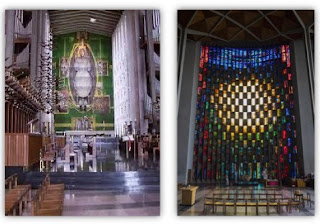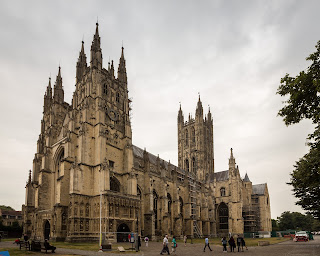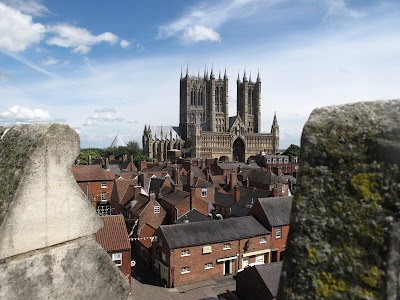A story of destruction and rebirth
The next 'stop' we've reached on our journey is Coventry. There have been three cathedrals in the city of Coventry. The first building, St Mary's Priory and Cathedral was built between 1095 and 1102. This lasted until 1539 when it was the only medieval cathedral to be demolished by Henry VIII's dissolution of the monasteries. The second building, St Michael's Church, had been constructed in the late 14th and early 15th centuries. It was originally a parish church bur was elevated to cathedral status in 1918.
On the night of 14th November 1940, a German raid over the city of Coventry destroyed the medieval Parish Church Cathedral of St Michael along with factories and over 4,000 houses. 568 people died in the attack.
The decision to rebuild the cathedral was taken the day after its destruction, but it was not until 1951 that a competition was held for the design of a new cathedral. There were 219 entries and the design chosen was by Basil Spence. His design was for a modern building, but he decided to retain the shell of the old building as a reminder of what happened. Spencer's design contained another interesting feature. He put the new building at right angles to the shell of the old building, making the altar of the new Coventry Cathedral sit at the north end of the building instead of the traditional east end.
The foundation stone was laid by Queen Elizabeth II on 23rd March 1956 and she also consecrated the building on 25th May 1962. On 30th May, Benjamin Britten's 'War Requiem' (written for the occasion) was performed in the new cathedral. The work is scored for orchestra, a separate chamber orchestra, chorus, a separate children's chorus and three soloists - soprano, tenor and baritone. The first performance was supposed to feature a Russian soprano, Galina Vishnevskaya, alongside the tenor, Peter Pears and baritone, Dietrich Fischer-Dieskau. However, the Russian authorities did not allow her to travel and instead her place was taken by British soprano, Heather Harper, whose name has became synonymous with the work ever since.
For those with a lot of time on their hands, you might like to watch this 50th Anniversary performance from Coventry Cathedral, performed by the City of Birmingham Symphony Orchestra under the baton of Andris Nelsons in 2012 - or even just a portion of it to get a flavour of this wonderful work.
Video credit: You Tube, City of Birmingham Symphony Orchestra - CSBO Britten's War Requiem: 50th Anniversary Performance (recorded by Unitel Classica)





Comments
Post a Comment